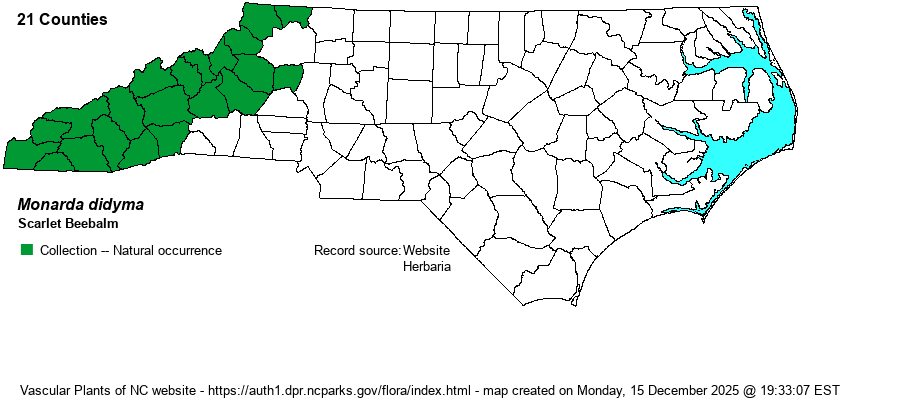| Author | L. | |
| Distribution | Limited essentially to the Mountains, but with one collection from Alexander County in the western Piedmont. SERNEC contains a handful of specimen records for scattered central and eastern Piedmont counties, but these are misidentifications or are likely escaped from cultivation; these are not mapped. Also not mapped are iNaturalist records from most counties east of the range documented with specimens, owing to escapes and plantings.
This is a Northern species ranging from eastern Canada south to NJ, PA, and eastern OH, and then southward in the Appalachians to northern GA. | |
| Abundance | Fairly common in the Mountains, being collected from all such counties. Very rare, if still present, in the western Piedmont. | |
| Habitat | This is a Monarda that requires some moisture, usually in shaded to partly shaded places. It occurs along wooded stream banks, in seepages on forested slopes, swampy spots, and also in boulderfield forests with some seepage. It does occur in Rich Cove Forests, but only if and where damp ground is present. |
| Phenology | Blooms from July to September, and fruits from September to October. | |
| Identification | This is certainly one of the most beautiful and favorite wildflowers of the summer season. It is a rather tall herb, growing to 3-4 feet tall on average, unbranched or with a few branches. It has several pairs of opposite stem leaves, each ovate to lanceolate, about 4-5 inches long, serrated on the margins, with a long and pointed tip, a rounded base, and a short petiole. As is well known, the single flower cluster at the ends of the stems and branches contains numerous scarlet to bright red flowers, each being about 1.3 inches long, with a narrow upper lip and also a narrow lower lip, widely separate by the open "mouth". About 10-20 flowers bloom simultaneously, each facing outward from a central axis; in addition, the bracts below the flower cluster are also red, though not deeply so. Other similar Monarda species in the mountains have different flower colors, with M. media being the closest in color, at bright purple. Though not nearly as common as M. clinopodia, it should be encountered in summer in many places across the mountains, especially if the red colors of the flowers are seen. | |
| Taxonomic Comments | Monarda media is variously considered as a good/full species, as in Weakley (2018) (and thus on this website), completely sunken within this species, or listed as a variety of it.
| |
| Other Common Name(s) | Bee-balm, Oswego Tea, Crimson Beebalm | |
| State Rank | S4 | |
| Global Rank | G5 | |
| State Status | | |
| US Status | | |
| USACE-agcp | FAC link |
| USACE-emp | FAC link |

